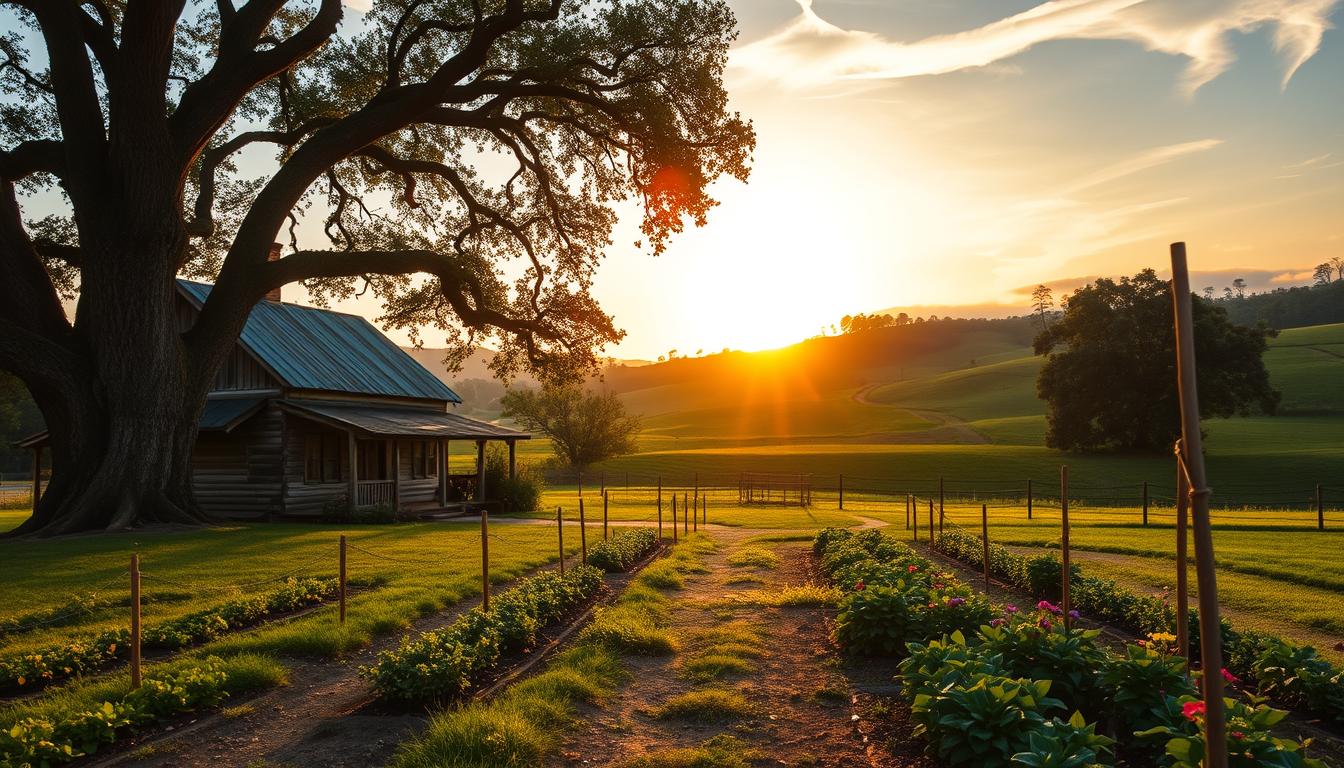Homesteading has seen a 200% surge in popularity over the last two years, with 72% of modern homesteaders starting their journey in urban or suburban areas. This lifestyle isn’t just about rural living—it’s about self-sufficiency, sustainability, and creating a fulfilling way of life. Whether you’re growing food in containers or raising chickens in your backyard, homesteading is accessible to everyone.
According to USDA data, homestead practices can reduce household food budgets by 33%, while increasing food security by 42%. A 15-year case study even found that 90% of homesteaders report high satisfaction with their lifestyle. The key? Start with skills, not land. 82% of successful homesteaders focus on learning essential skills before expanding their operations.
Homesteading is more than a trend—it’s a journey toward independence and resilience. With the right approach, you can create a thriving homestead, no matter where you live.
Key Takeaways
- Homesteading popularity has increased by 200% in the last two years.
- 72% of modern homesteaders begin in urban or suburban areas.
- Homestead practices can reduce food budgets by 33%.
- Food security improves by 42% through homesteading.
- 90% of homesteaders report high satisfaction with their lifestyle.
- Focus on learning skills before expanding your homestead.
What Is Homesteading and Why Start Now?
Modern homesteading blends traditional skills with today’s technology for a sustainable lifestyle. It’s about creating a self-sufficient way of life, whether you’re in the city or the countryside. This movement is growing fast, with 73% of homesteaders combining old-school techniques with modern tools.
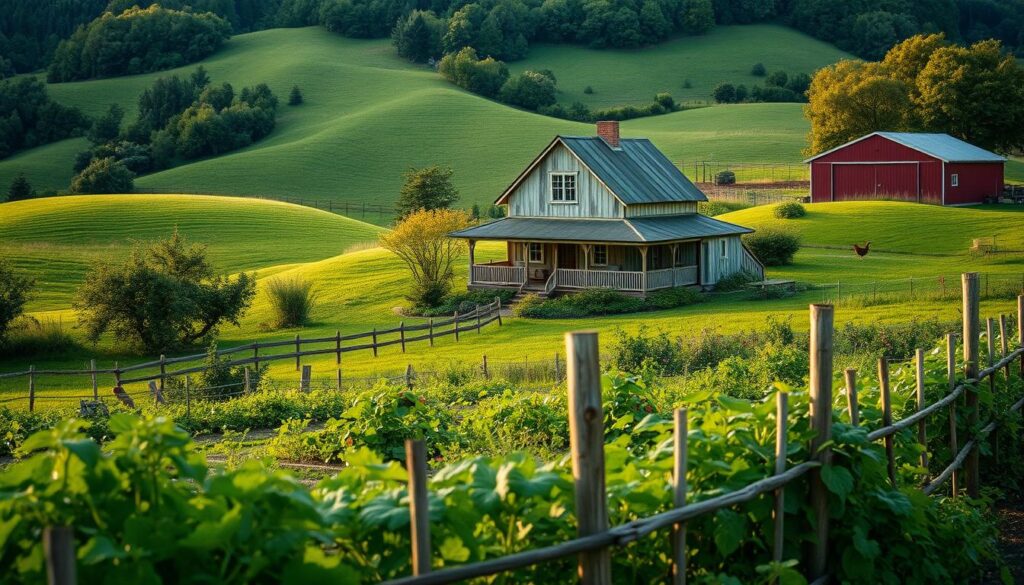
Understanding the Homesteading Lifestyle
Homesteading is more than just growing your own food—it’s a mindset. It’s about taking control of your resources and reducing dependence on external systems. Many people find that this lifestyle improves their mental health, with 61% reporting a boost in well-being.
Urban homesteaders are proving that space isn’t a barrier. In fact, 89% of them maintain productive gardens in areas smaller than 200 square feet. This shows that anyone can start, no matter where they live.
Benefits of Building a Homestead
Starting a homestead offers numerous advantages. For one, it can significantly reduce your grocery bills. On average, homesteaders save $1,800 annually on food costs. Plus, 54% report relying less on grocery stores, which means fresher, healthier meals.
Environmental benefits are another big draw. Each homestead reduces CO2 emissions by 2.3 tons annually. Many also achieve 47% energy independence through renewable sources like solar and wind power.
Financially, homesteading makes sense. Beyond savings on food, it fosters a self-sufficient mindset that can lead to long-term stability. Whether you’re looking to save money, improve your health, or reduce your environmental impact, homesteading is a rewarding path to explore.
Define Your Homesteading Vision
Crafting a clear vision is the cornerstone of any successful homesteading journey. Without it, 68% of failed projects cite unclear direction as the primary reason. A well-thought-out vision ensures your efforts align with your long-term goals and values.
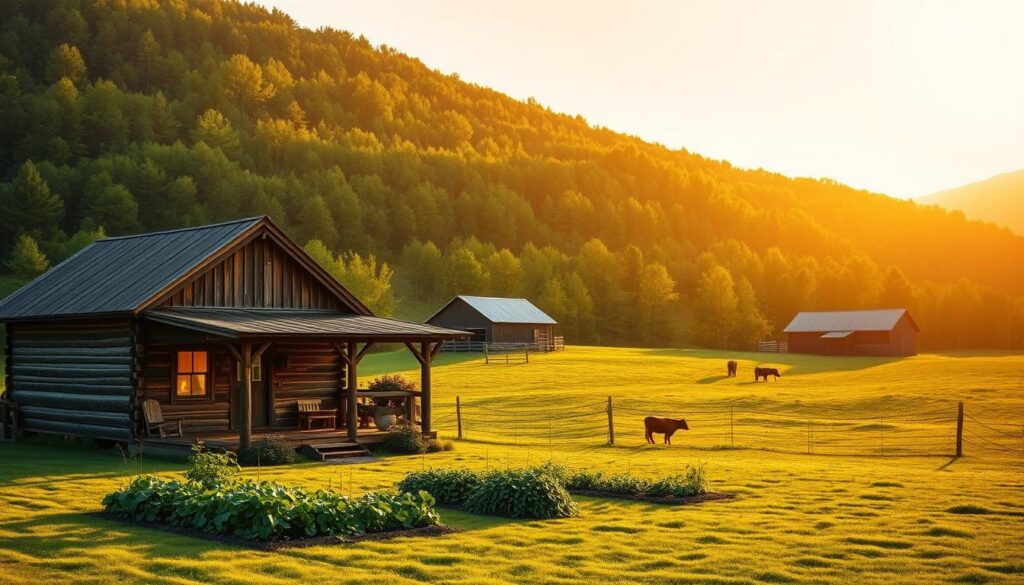
Ask Yourself the Right Questions
Start by asking essential questions to shape your vision. For example, where will your water come from? Surprisingly, 78% of new homesteaders overlook this critical detail. Another common issue is zoning compliance, which affects 63% of projects.
Consider how your family fits into this plan. Are you all on the same page? Partner alignment is crucial, with 94% of successful homesteads involving both partners in planning. These questions help you avoid costly mistakes and set a solid foundation.
Set Realistic Goals for Your Homestead
Once your vision is clear, break it into actionable goals. Many successful homesteaders use the SMART framework—Specific, Measurable, Achievable, Relevant, and Time-bound. For instance, transitioning from growing wheat to baking bread might take 18 months, as seen in one case study.
Here’s a simple 3-phase implementation model used by 82% of sustainable homesteads:
| Phase | Focus | Timeline |
|---|---|---|
| 1 | Planning & Skill Development | 0-6 months |
| 2 | Small-Scale Implementation | 6-18 months |
| 3 | Expansion & Optimization | 18-60 months |
Remember, your vision should balance ambition with practicality. Whether it’s generating income or creating a self-sufficient lifestyle, your goals should reflect your unique aspirations.
“A clear vision and realistic goals are the backbone of any successful homesteading journey.”
Assess Your Financial Situation
Before diving into homesteading, it’s crucial to evaluate your financial health. A strong financial foundation ensures your dreams stay on track. Start by reviewing your debt, income, and expenses. This step helps you avoid unnecessary stress and sets the stage for success.
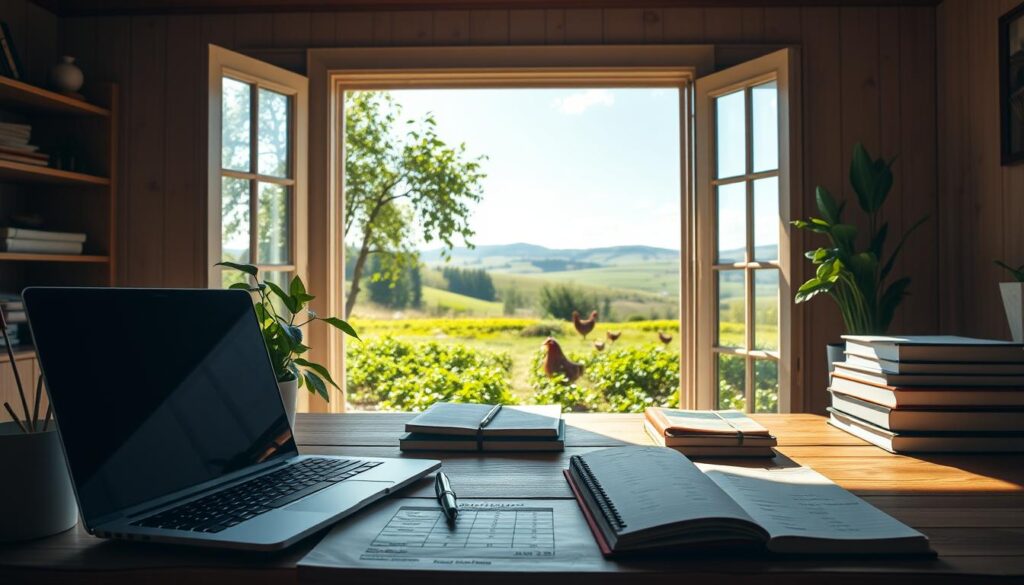
Pay Off Debt Before Starting
Clearing debt is a priority for 73% of homesteaders. Many use the debt snowball method, paying off smaller balances first. This approach builds momentum and frees up money for your projects. Remember, starting debt-free reduces financial pressure and allows you to focus on your goals.
Create a Budget for Your Homestead
A well-planned budget is essential. Consider using the 10/10/80 rule: 10% for savings, 10% for giving, and 80% for expenses. This framework helps you allocate resources wisely. Don’t forget to include an emergency fund—experts recommend saving 6-9 months’ worth of living costs.
Here are some tips to maximize your income:
- 47% of homesteaders sell excess produce for extra cash.
- 33% craft goods like candles or soap to supplement their earnings.
- Use 5-year financial projection templates to plan long-term.
“A clear financial plan is the key to turning your homesteading vision into reality.”
Choose the Right Property for Your Homestead
Selecting the perfect piece of land is a critical step in creating a sustainable homestead. With 62% of homesteaders regretting their initial choices, it’s essential to evaluate key factors carefully. Water access and sun exposure are among the top considerations, with 91% and 87% of successful homesteaders prioritizing them, respectively.
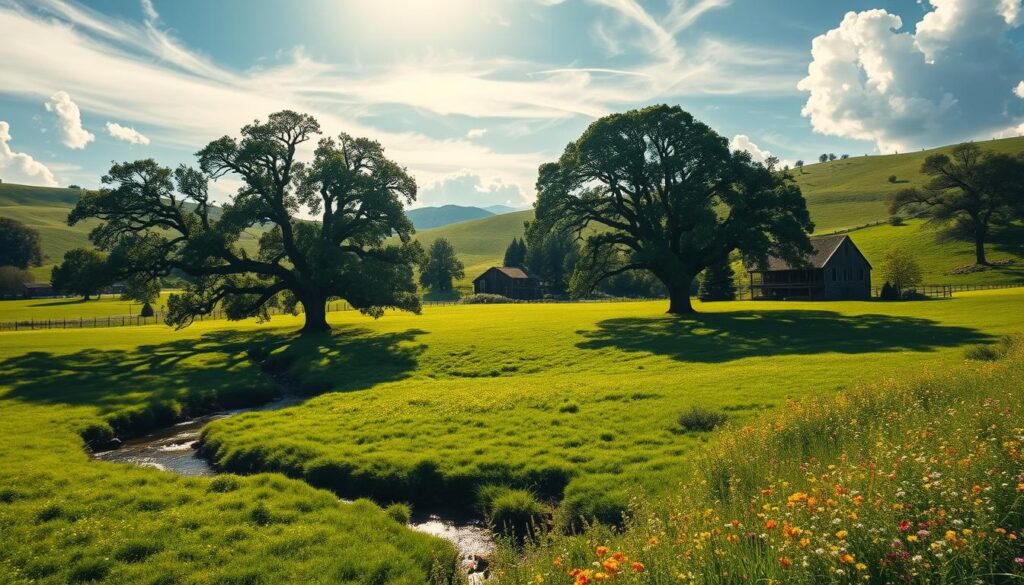
Factors to Consider When Selecting Land
When choosing property, start by assessing the soil quality. A soil test can reveal pH levels, nutrient content, and potential contaminants. This ensures your land is fertile and suitable for growing crops or raising livestock.
Sun exposure is another critical factor. Analyze the solar path to determine how much sunlight your land receives daily. This is especially important for gardening and solar energy systems.
Water access is non-negotiable. Whether it’s a well, stream, or rainwater harvesting system, ensure your property has a reliable water source. Understanding water rights—riparian vs. prior appropriation—can also prevent legal issues down the road.
Understanding Zoning Laws and Restrictions
Zoning laws can make or break your homesteading plans. Research local regulations to ensure your intended activities—like raising livestock or building structures—are permitted. With proper preparation, 68% of zoning variance requests are approved.
Here’s a quick guide to navigating zoning laws:
| Factor | Importance | Tips |
|---|---|---|
| Livestock Density | High | Calculate the number of animals per acre to comply with local rules. |
| Building Permits | Critical | Check requirements for sheds, coops, and other structures. |
| Agricultural Use | Essential | Ensure your land is zoned for farming or gardening. |
By addressing these factors, you can avoid costly mistakes and set your homestead up for long-term success.
“Choosing the right land and understanding zoning laws are the foundation of a thriving homestead.”
Start Small: Begin Homesteading Where You Are
You don’t need vast acres to start your journey toward self-sufficiency. Whether you’re in an urban apartment or a suburban backyard, there are ways to embrace the homesteading lifestyle. Starting small allows you to build skills and confidence without overwhelming yourself.
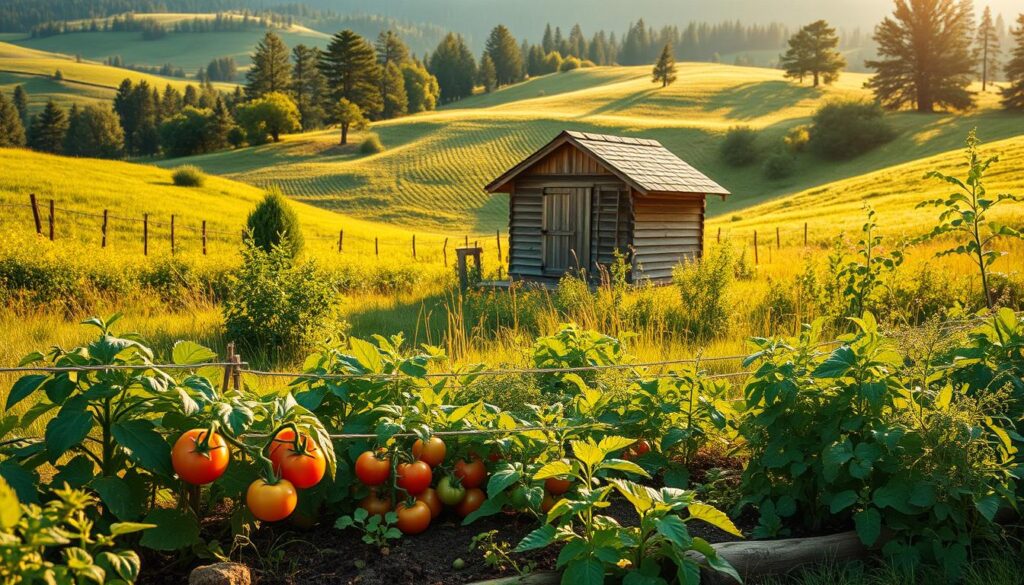
Urban Homesteading Tips
Living in the city doesn’t mean you can’t homestead. With creativity, even a balcony can become a productive space. For example, 82% of urban dwellers succeed with balcony gardens. Here are some practical ideas:
- Grow high-yield crops like tomatoes, peppers, herbs, lettuce, and radishes in containers.
- Use vertical gardening systems to maximize limited space.
- Check local laws—63 municipalities allow backyard chickens or micro-livestock like quail or rabbits.
- Partner with community gardens, which have a 71% success rate for urban gardeners.
- Compost kitchen scraps using compact solutions like worm bins or bokashi systems.
Suburban Homesteading Ideas
Suburban areas offer more flexibility for homesteading. With a bit of planning, you can create a thriving small-scale homestead. Here’s how:
- Start with a vegetable garden, focusing on crops that grow well in your climate.
- Raise chickens or bees if local zoning laws permit—47% of suburban homesteaders keep micro-livestock.
- Install rain barrels to collect water for irrigation.
- Use raised beds or square-foot gardening to optimize your space.
- Explore renewable energy options like solar panels to reduce your environmental impact.
No matter where you start, the key is to take the first step. Homesteading is about progress, not perfection. Begin with what you have, and grow from there.
“The best way to start is to start small and let your homestead evolve naturally.”
Learn Essential Homesteading Skills
Mastering essential skills is the foundation of a successful homesteading journey. Whether you’re growing your own food or raising animals, these abilities ensure self-sufficiency and sustainability. Start with the basics, and gradually expand your expertise as you gain confidence.

Gardening Basics for Beginners
Gardening is a cornerstone of homesteading. Begin by choosing the right seeds and method for your climate. Hydroponic systems have a 92% success rate for seed starting, while traditional soil methods work well for beginners. Focus on easy-to-grow crops like tomatoes, lettuce, and herbs.
Here’s a quick comparison of seed starting methods:
| Method | Success Rate | Best For |
|---|---|---|
| Hydroponic | 92% | Fast growth, limited space |
| Soil | 85% | Traditional gardening, beginners |
Remember, consistent watering and sunlight are key to healthy plants. Start small, and expand your garden as you gain experience.
Raising Chickens and Other Livestock
Chickens are a popular choice for homesteaders, with 94% of them keeping poultry. Most start with 3-5 chickens, which require about 35 minutes of daily care. Proper coop design and predator protection are essential for their safety.
Here are some tips for raising chickens:
- Choose a coop design that maximizes space and ventilation.
- Install predator-proof fencing, which is 87% effective.
- Learn to identify and treat common poultry diseases early.
If you’re ready to expand, consider adding other livestock like goats or rabbits. Each animal has unique needs, so research thoroughly before making a decision.
“Start with chickens—they’re low-maintenance and provide fresh eggs daily.”
By mastering these skills, you’ll create a thriving homestead that meets your needs and goals.
Plan Your Homestead Layout
Efficiency starts with a smart and sustainable design. A well-planned layout not only saves time but also reduces labor by up to 42%. With 76% of homesteaders using permaculture principles, it’s clear that thoughtful planning is essential for success.
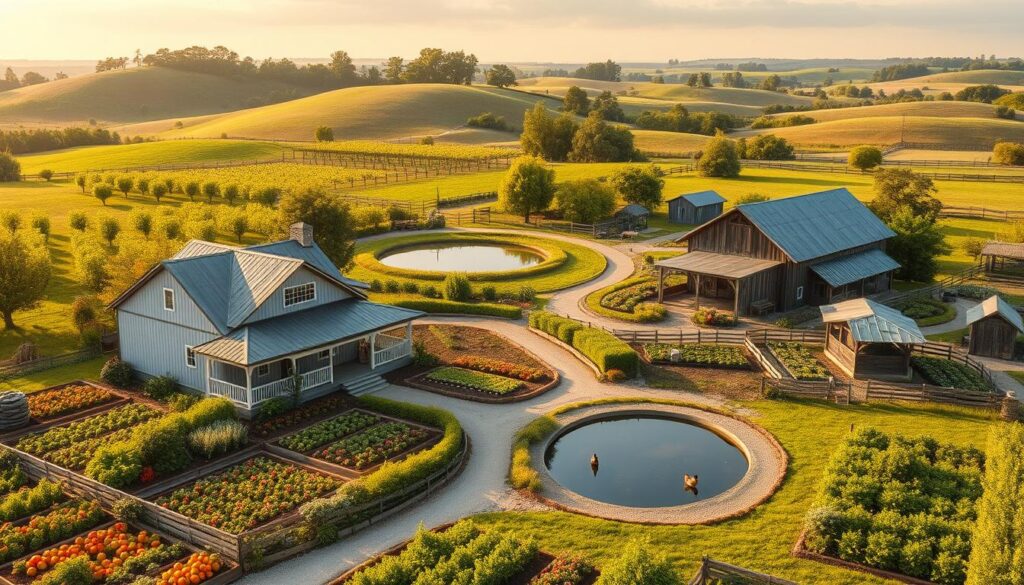
Designing for Efficiency and Sustainability
Start by mapping out your space to maximize efficiency. Use the 5-zone system to organize areas based on frequency of use. Zone 1, closest to your home, should include high-maintenance gardens and daily-use items. Zone 5, the farthest, can remain wild for natural habitats.
Sun mapping is another critical step. Track sunlight patterns to place gardens and solar panels in optimal spots. This ensures your plants thrive and your energy systems work effectively.
Where to Place Gardens, Coops, and Barns
Strategic placement of key elements can make a big difference. Gardens should be near water sources for easy irrigation. Coops and barns benefit from windbreaks, which protect animals from harsh weather and reduce heating costs.
Livestock rotation patterns are also important. Moving animals between pastures prevents overgrazing and keeps soil healthy. This approach aligns with permaculture principles, promoting sustainability.
Don’t forget emergency access. Ensure all areas are reachable in case of fire or other emergencies. This is a safety measure that 68% of homesteaders prioritize.
“A smart layout is the foundation of a thriving homestead—plan with purpose and watch your efforts flourish.”
- Zone planning: Organize areas based on use frequency.
- Sun mapping: Track sunlight for optimal placement.
- Windbreak placement: Protect structures and animals.
- Livestock rotation: Maintain soil health and prevent overgrazing.
- Emergency access: Ensure safety and accessibility.
Build a Self-Sufficient Garden
Creating a self-sufficient garden is a rewarding step toward sustainability. It provides fresh, healthy food while reducing reliance on grocery stores. With proper planning, you can enjoy a thriving garden that meets your needs year-round.
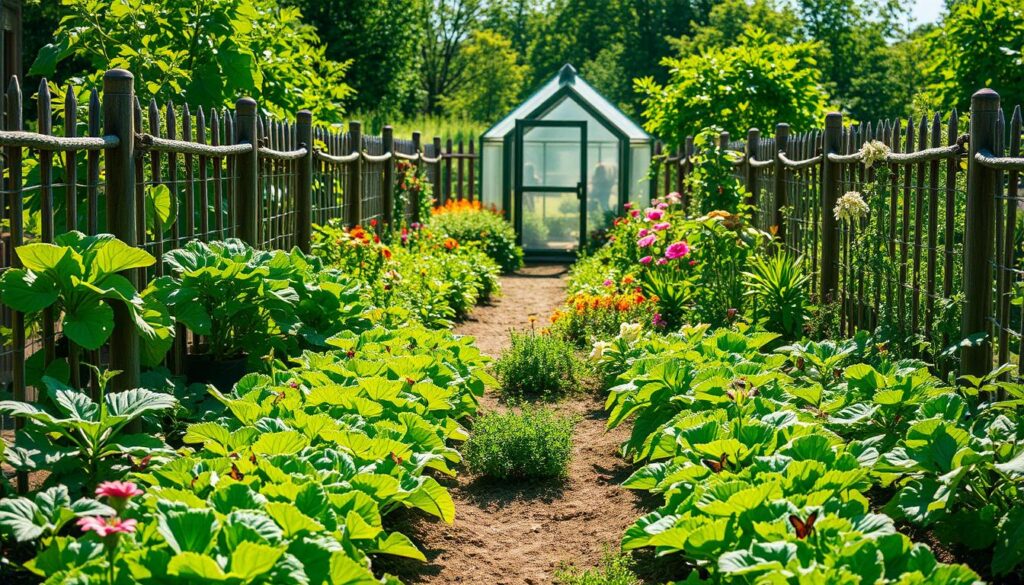
Choosing the Right Crops for Your Climate
Selecting the right crops is essential for a successful garden. Start by understanding your climate and USDA hardiness zone. This ensures your plants thrive and produce a bountiful harvest. Focus on high-yield, low-maintenance options like tomatoes, beans, and leafy greens.
Here’s a quick guide to high-calorie crops per square foot:
| Crop | Calories/sq ft |
|---|---|
| Potatoes | 480 |
| Sweet Potatoes | 450 |
| Beans | 420 |
Consider your soil quality too. A simple test can reveal pH levels and nutrient content, helping you choose the best crops for your garden.
Preserving Your Harvest for Year-Round Use
Proper preservation ensures your hard work lasts all year. Canning, dehydrating, and freezing are popular methods. Each has its benefits, so choose what works best for your needs. For example, canning preserves nutrients but requires careful attention to pH balance.
Here’s a comparison of preservation methods:
| Method | Nutrition Retention |
|---|---|
| Canning | High |
| Dehydration | Moderate |
| Freeze-Drying | Very High |
Root cellars are another excellent option. They maintain four distinct temperature zones, ideal for storing root vegetables and other produce. By preserving your harvest, you can reduce waste by up to 85%.
“A well-preserved harvest ensures you enjoy fresh, homegrown food all year long.”
Explore Renewable Energy Options
Harnessing renewable energy is a game-changer for modern self-sufficiency. With 58% of homesteaders achieving 75% energy independence, it’s clear that sustainable power solutions are within reach. Whether you’re considering solar, wind, or hybrid systems, these options can reduce your environmental impact and lower long-term costs.
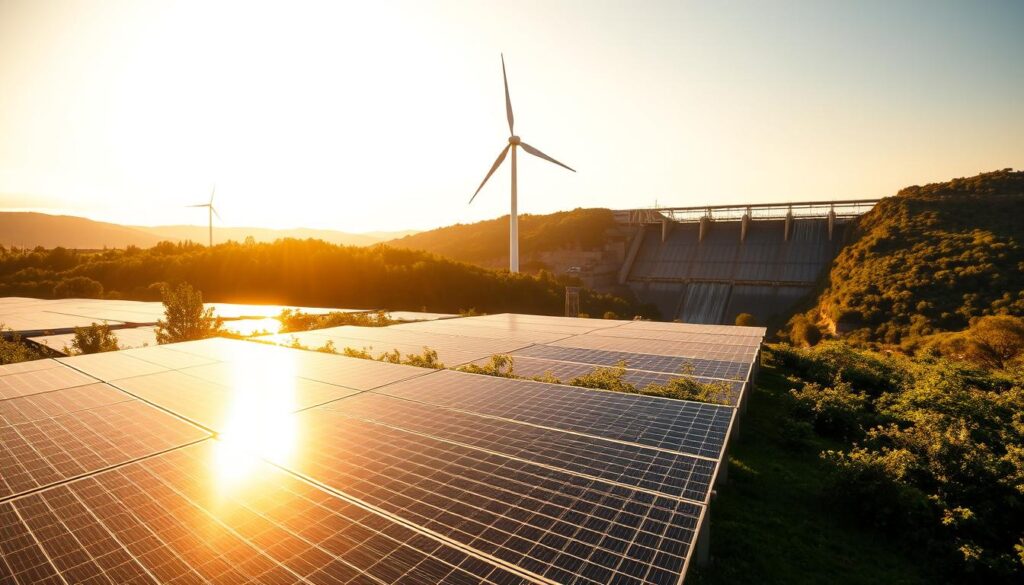
Solar and Wind Power for Homesteads
Solar panels are a popular choice for homesteaders. On average, the return on investment (ROI) timeline is 5-7 years, making it a cost-effective solution. Pairing solar with battery storage ensures you have power even during cloudy days or outages.
Wind turbines are another excellent option, especially in areas with consistent wind speeds. Hybrid systems, combining solar and wind, are used by 42% of homesteaders to maximize efficiency. These setups provide reliable energy year-round.
Here’s a quick comparison of renewable energy options:
- Solar: Best for sunny climates, 5-7 year ROI.
- Wind: Ideal for windy areas, requires more space.
- Hybrid: Combines both for consistent power.
Going Off-Grid: Is It Right for You?
Living off-grid offers complete independence but requires careful planning. Start with an energy audit to assess your needs. This process helps you determine the right systems and storage solutions for your homestead.
Micro-hydro power is another option if you have access to flowing water. It’s highly efficient and can generate energy 24/7. However, it requires specific conditions to be viable.
Generator backups are essential for off-grid setups. They provide power during extended periods of low renewable output. Choose a model that matches your needs and fuel availability.
“Renewable energy isn’t just about saving money—it’s about creating a sustainable future.”
For more details on solar panel basics, check out this comprehensive guide.
Manage Your Homestead’s Water Supply
Ensuring a reliable water supply is crucial for a thriving self-sufficient lifestyle. Whether you’re collecting rainwater or optimizing irrigation, smart planning can make all the difference. With 1 inch of rain yielding 600 gallons per 1,000 square feet, efficient systems can transform your homestead’s sustainability.
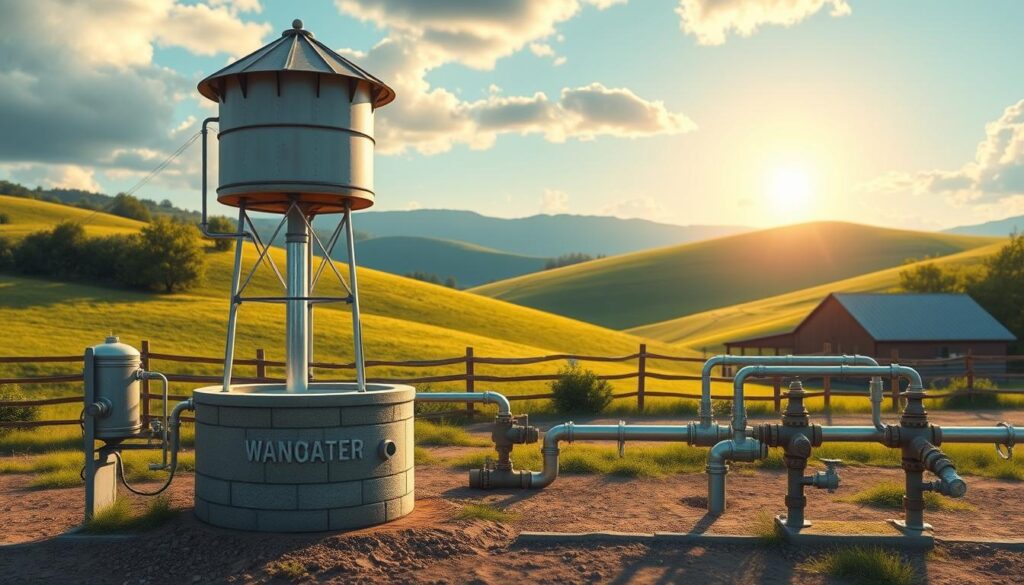
Rainwater Harvesting Systems
Rainwater harvesting is a game-changer for self-sufficiency. Start by calculating your cistern size based on rainfall and roof area. For example, a 1,000-square-foot roof can collect 600 gallons from just 1 inch of rain. Pair this with a reliable filtration system to ensure clean, usable water.
Here’s a quick guide to cistern sizing:
| Roof Area (sq ft) | Rainfall (inches) | Water Collected (gallons) |
|---|---|---|
| 1,000 | 1 | 600 |
| 1,500 | 2 | 1,800 |
Don’t forget to check local greywater guidelines. Many areas allow its use for irrigation, reducing reliance on fresh water sources.
Irrigation Techniques for Dry Climates
In arid regions, efficient irrigation is essential. Drip irrigation is a top choice, used by 87% of homesteaders in dry climates. It delivers water directly to plant roots, minimizing waste and maximizing efficiency.
Swales are another effective solution. These shallow trenches capture and redirect rainwater, improving soil moisture. Pair them with drought-resistant crops like quinoa, amaranth, and millet for optimal results.
“Smart water management ensures your homestead thrives, even in challenging conditions.”
Prepare for Challenges and Setbacks
Facing challenges is an inevitable part of the homesteading journey. Whether it’s unexpected weather, crop failure, or financial strain, setbacks can test your resilience. However, with proper preparation and a proactive mindset, you can navigate these problems and keep your goals on track.
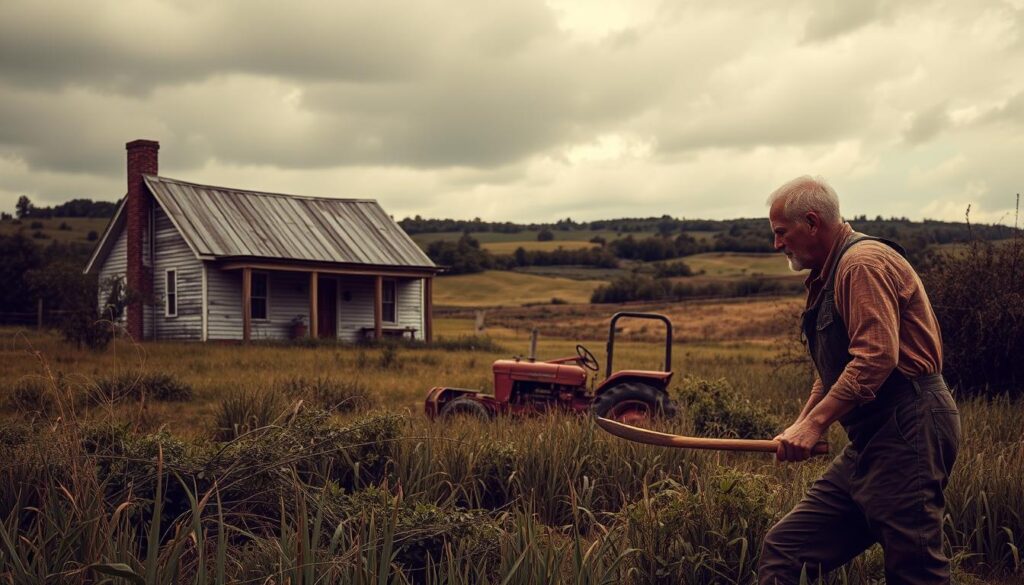
Did you know that 78% of homesteaders experience a major setback in their first year? Additionally, 63% under-budget by 40%, leading to financial stress. Understanding common mistakes and having a plan to handle unexpected issues can make all the difference.
Common Homesteading Mistakes to Avoid
One of the most costly errors is neglecting predator protection. Unsecured coops or gardens can lead to significant loss of livestock or crops. Another common issue is underestimating the time and resources needed for daily care of animals and plants.
Here are the top 5 mistakes to watch out for:
- Failing to secure coops and gardens from predators.
- Underestimating water and feed requirements for livestock.
- Ignoring soil health, leading to poor crop yields.
- Overlooking local zoning laws and regulations.
- Not having an emergency fund for unexpected expenses.
How to Handle Unexpected Issues
When problems arise, having a plan in place can save time and resources. For example, create emergency protocols for livestock health, such as identifying symptoms of common diseases and having a vet on call. Crop failure recovery strategies, like rotating crops and using cover crops, can also mitigate loss.
Here’s a quick guide to handling unexpected issues:
| Issue | Solution |
|---|---|
| Predator Attacks | Install secure fencing and motion-activated lights. |
| Livestock Illness | Keep a first-aid kit and establish a relationship with a local vet. |
| Crop Failure | Rotate crops, test soil, and use organic fertilizers. |
| Financial Strain | Create a detailed budget and set aside an emergency fund. |
| Zoning Disputes | Research local laws and apply for necessary permits in advance. |
Mental resilience is equally important. Homesteading can be demanding, so practice self-care and seek support from the community when needed. Remember, every challenge is an opportunity to learn and grow.
“The key to overcoming setbacks is preparation, adaptability, and a positive mindset.”
Connect with the Homesteading Community
Building connections with others can transform your homesteading experience. Whether you’re just starting or looking to expand your skills, the community around you is a valuable resource. From local meetups to online forums, there are countless ways to find support and share knowledge.
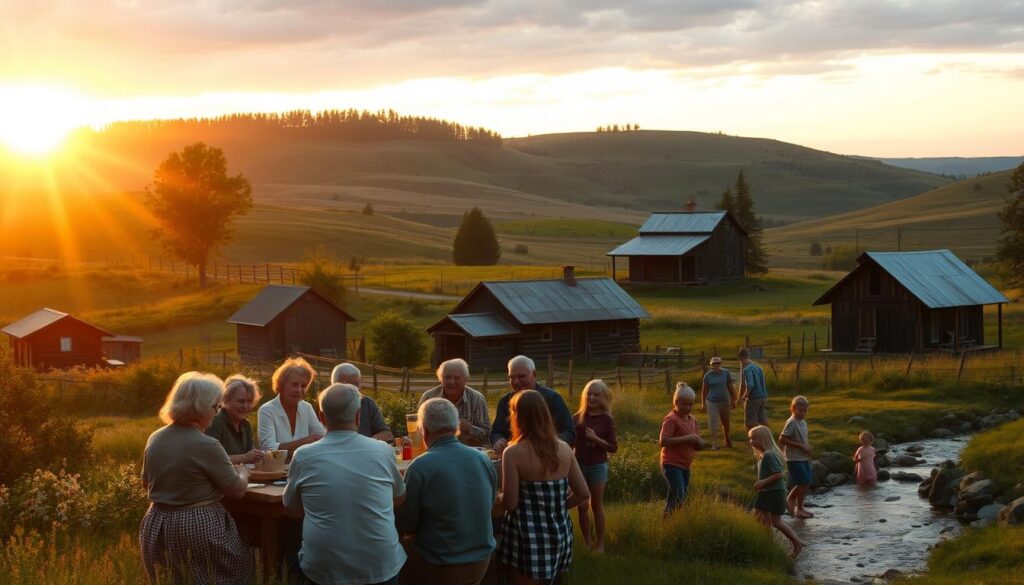
Finding Local Resources and Support
Local resources are essential for success. Start by joining nearby homesteading groups or attending workshops. Many areas have co-ops or farmers’ markets where you can exchange goods and ideas. These connections often lead to mentorship opportunities, which 92% of homesteaders say accelerate their progress.
Here are some ways to tap into local support:
- Attend skill-sharing events, where 67% of participants gain new abilities.
- Join crisis mutual aid networks for emergency assistance.
- Explore apprenticeship programs with high success rates.
Learning from Experienced Homesteaders
Experienced homesteaders are a treasure trove of knowledge. Seek out mentors who can guide you through challenges and share practical tips. Many offer certification paths for mastering advanced skills. Learning from their experiences can save you time and effort.
Here’s how to make the most of these relationships:
- Engage in barter systems to exchange goods or services.
- Use online platforms to connect with experts worldwide.
- Participate in forums or social media groups focused on homesteading.
“The homesteading community is built on collaboration and shared wisdom—embrace it to grow and thrive.”
Conclusion: Your Homesteading Journey Begins Today
Your path to self-sufficiency starts with a single step. With an 89% satisfaction rate after three years, homesteading offers a rewarding journey toward independence. Whether you’re growing food or raising animals, the key is to start small and build momentum.
Consider a 30-day challenge to kick off your journey. Track your progress using templates and review your goals annually. Planning for the future ensures long-term success and creates a legacy to pass on to the next generation.
With 76% of homesteaders recommending this lifestyle, you’re joining a supportive community. Embrace the freedom and fulfillment that comes with self-sufficiency. Your homesteading adventure begins now—take that first step today!

